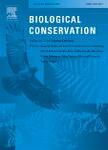版权所有:内蒙古大学图书馆 技术提供:维普资讯• 智图
内蒙古自治区呼和浩特市赛罕区大学西街235号 邮编: 010021

作者机构:Chinese Acad Sci Inst Zool Key Lab Anim Ecol & Conservat Biol 1 Beichen West Rd Beijing 100101 Peoples R China Univ Veracruz Fac Biol Circuito Gonzalo Aguirre Beltran S-N Xalapa 91090 Veracruz Mexico Chinese Acad Sci Chengdu Inst Biol Meilingshiguan Food Unit Chengdu 610000 Sichuan Peoples R China Sichuan Stn Wildlife Survey & Management Chengdu 610082 Sichuan Peoples R China Univ Chinese Acad Sci Beijing 100049 Peoples R China
出 版 物:《BIOLOGICAL CONSERVATION》 (生物保护)
年 卷 期:2019年第232卷
页 面:35-42页
核心收录:
学科分类:0710[理学-生物学] 0830[工学-环境科学与工程(可授工学、理学、农学学位)] 07[理学] 09[农学] 0713[理学-生态学]
基 金:Chinese Academy of Sciences, China [QYZDY-SSW-SMC019] National Key Program of Research and Development, Ministry of Science and Technology of China [2016YFC0503200] Chinese Academy of Sciences President's International Fellowship Initiative [2018VBB0017]
主 题:Ailuropoda melanoleuca Extreme weather events Flood disturbance Habitat use Human density Nature reserves
摘 要:As certain extreme weather events are becoming frequent and intense, conservationists must identify areas across species ranges recurrently affected, especially with regard to threatened species. Focusing on the giant panda (Ailuropoda melanoleuca) and historical flood frequency distribution, we determined overlaps between panda distribution affected by floods and nature reserves. We also examined the correspondence between areas subject to high flood exposure densities, areas with high panda habitat use, and areas that exhibit high human density. Of the 67 reserves established for giant panda conservation 7 included areas with the highest flood exposure densities while having a mean exposure ranging between 20 and 75%. In Sichuan province up to 32% of areas of high habitat use were subject to low flood density, and 10% overlapped with areas subject to high flood density. We also found that 40% of the total area with high human density was subject to a high flood density. Our findings indicate that high frequency of flooding is affecting areas of nature reserves where people are rather than areas which pandas are using more intensively. In areas occupied by pandas, strategies should remain focus on mitigating habitat degradation and fragmentation caused by human activities that can also reduce habitat resilience to floods. Management aimed at reducing vulnerability and enhancing resilience in flood-prone areas is warranted if we are to prevent negative indirect impacts on panda habitat driven by human responses to increasingly frequent and intense extreme weather events in the coming decades.